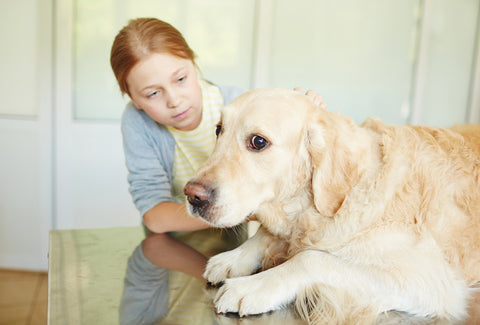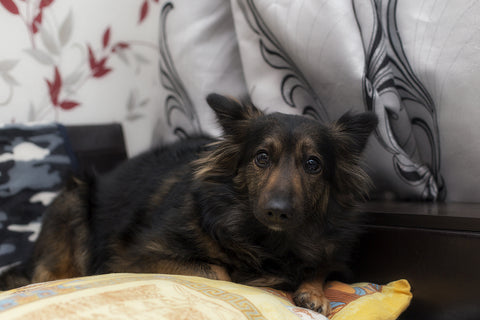As a pet parent, it can be troubling to see your furry family member stressed out by storms, sirens or other loud noises. You may have heard that firm but gentle pressure — like the kind you get from a hug — can help animals feel calmer and more relaxed. We review how weighted blankets for dogs work and how one might help your pup feel safer and more secure.

Weighted Blankets For Dogs Might be the Antidote to Thunder and Loud Sirens
Does your four-legged family member stress out every time an ambulance passes the house? Or maybe your dog runs for his favorite hiding spot whenever thunder crashes outside? Even the clanking and rumbling of the garbage truck can rile up certain dogs.
And don’t even get us started on fireworks.
According to the Humane Society of the United States, many dogs become anxious and fearful when they hear loud noises. In fact, dogs can develop this type of fear even if they’ve never had a traumatic experience associated with loud noise.
Some dogs with noise-related anxiety whine or try to hide. However, other dogs who experience this kind of anxiety become destructive — a trait that can pose many hassles for pet owners who work outside the home and need to leave their dogs home alone during the day. And if your pooch tries to gnaw the legs off your sofa during late-night thunderstorms, the whole household could be in for a sleepless night.
If your dog’s fear is keeping you up at night or ruining your furniture (or woodwork), there are definitely ways to help ease noise-related anxiety and fear.
How to Help Reduce Anxiety in Dogs
The Humane Society recommends tackling your dog’s noise anxiety in three steps. Just like people, all dogs are different. Your dog may respond well to the first step, which means you might not even need to use the other two. The key is to be patient and understand that doggy anxiety can be treated as long as you (and your pup) are willing to work at it.
Make a Safe Space
We all have our favorite places to go when we’re sick, upset or just trying to shake off the effects of a bad day. As kids, many of us even snuggled under the covers during a loud thunderstorm.
Dogs are much the same. Like us, they crave safe, comfortable spaces where they can relax and feel secure. The Humane Society says it’s key to create a safe space that appeals to your dog — not necessarily you. Keep an eye on where they tend to retreat when the rain starts pounding the roof or kids next door set off firecrackers on the Fourth of July. If your dog has a go-to spot for loud noises, make it more inviting by providing a bed, blanket or some favorite toys.
However, you shouldn’t make a safe space mandatory. Forcing your dog into a confined area can backfire and make the fear worse.
Provide Distractions
You can also try distracting your dog from his fear. The Humane Society recommends using this technique at the onset of your dog’s fear — otherwise, he might be too worked up to cooperate.
For example, at the first few rumbles of thunder, you could try a little indoor fetch. Or, if your dog enjoys baths, run some warm water and suds him up in the tub. You can also try running a fan or white noise machine to help muffle the troublesome sounds.
Try Behavior Modification
In some cases, you can help ease a dog’s noise-related anxiety by gently and slowly exposing him to the sounds that bother him — a technique called “desensitization.” However, the Human Society cautions that you should do this very gradually and carefully.
When you use desensitization, you try to help your dog associate the source of his fear with a good thing. For example, some people play a recording of a firecracker noise at a very low, soft level. As they play the recording, they give their dog a treat and praise him. Over time, you can gradually raise the volume (and make sure to give your dog a treat and praise each time). Eventually, your dog may start to associate the noise with a pleasant experience rather than a fearful one.
Whichever tactic you try, it’s best to first discuss it with your veterinarian. Your pet’s health and well-being are important, so run it by your vet before you dig in.
Deep Touch Therapy for Dogs

There is another technique that could help your dog cope with a fear of loud noises, and it’s one that is backed by scientific research. For years, medical professionals and occupational therapists have used weighted blankets to help children and adults with anxiety and related conditions feel calmer and more relaxed.
Weighted blankets work by providing firm but gentle pressure throughout the body. Known as “deep touch pressure,” this type of touch therapy provides all the benefits of hugging, which is known to increase the production of the feel-good chemical melatonin.
Research published in the Journal of Sleep Medicine & Disorders states, “The application of deep pressure, through for example weighted vests and blankets, has been reported to produce a calming and relaxing effect in clinical conditions such as autism spectrum disorders (ASD), attention-deficit hyperactivity disorder, and pervasive developmental disorders.”
In a separate study published in the journal Occupational Therapy in Mental Health, researchers found that 63 percent of study participants who used a weighted blanket felt less anxious, and another 78 percent “preferred the weighted blanket as a calming modality.”
So what does this mean for your pooch? Like humans, dogs may feel less anxious when exposed to firm, gentle pressure reminiscent of a hug. A 2017 study published in the Journal of the American Association for Laboratory Animal Science showed that dogs who wore a pressure vest had lower heart rates and less anxiety. Compared to dogs who did not wear a pressure vest, dogs with vests had 8 percent lower heart rates and 38 percent lower mean anxiety rates.
How to Order a Weighted Blanket for Your Dog

Many parents of anxious pups have heard of compression vests and “undershirts” for dogs. While these shirts can work really well, not all dogs tolerate them. Because the shirts fit close to the body and act like a “swaddle,” they may not work for all dogs. Pet owners report mixed results, with some saying their dog seemed less anxious while wearing the shirt and others saying it made no difference.
One of the differences between dog-specific undershirts and weighted blankets is the lack of weight in the undershirts. Whereas the undershirts are close-fitting and may provide some pressure, they contain no additional weight beyond the slight weight of the fabric.
By contrast, weighted blankets are weighted, which provides the firm, gentle pressure used in actual deep touch pressure therapy. Also, they don’t attach to the dog’s body, which means the dog is free to move around at any time. At SensaCalm, we also make weighted wraps, which are great for dogs, as they come in both three-pound and five-pound weights. We make our custom weighted blankets to order, so just contact us to request a specific weight for your pet. We also offer finished, ready-to-ship weighted blankets that ship the next business day after your order.
Additionally, our weighted blankets and wraps are safe for the washer and dryer, so you can throw them in the laundry whenever you need to.
SensaCalm Weighted Blankets for Dogs
Want your dog to feel calmer and less anxious when the storm clouds gather? A weighted blanket may help your pet tolerate noise without hiding or howling. SensaCalm weighted blankets and wraps are made in the U.S.A. and are available in a wide range of sizes, colors and patterns.
Questions? We’re here to help! Get in touch by calling us at 855-736-7222, or use our online contact form to speak with a member of our experienced team.
Disclaimer: The content on this website is not intended as a substitute for medical advice. Talk to your doctor, veterinarian or healthcare provider before undertaking any type of therapy or treatment.


